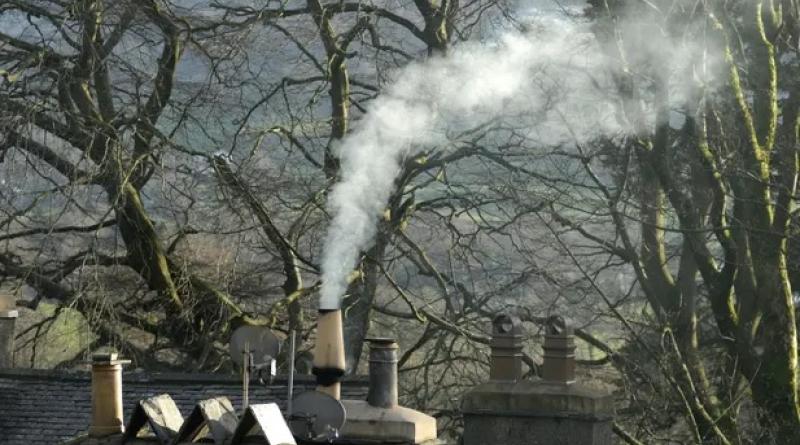Wood burners cause nearly half of urban air pollution cancer risk – study

Exclusive: Wood smoke is a more important carcinogen than vehicle fumes, finds Athens analysis
Wood burning stoves in urban areas are responsible for almost half of people’s exposure to cancer-causing chemicals found in air pollution particles, new research has shown.
The polycyclic aromatic hydrocarbons (PAHs) in tiny pollution particles are produced by burning fuels and have long been known to have carcinogenic effects. The new study examined the sources of the PAHs and found wood burning produced more than the diesel fuel or petrol used in vehicles.
The analysis was done in Athens, Greece, but the researchers were clear that this was not an unusual case. They said that home wood burning was a significant issue for urban air quality throughout Europe and that excessive exposure to wood smoke could cause severe health effects.
“Athens is not an exception – it’s more representative of a rule,” said Athanasios Nenes, at the Foundation for Research and Technology Hellas in Patras, Greece, and the École Polytechnique Fédérale de Lausanne, Switzerland, and one of the team behind the new study. “On the one hand, it’s: ‘Oh, my goodness, this is terrible.’ But on the other hand, it points to something people can actually do to reduce this risk without too much effort. You basically stop burning wood. That’s the bottom line.”
Research published in the last year has shown wood burning in homes is the single biggest source of small particle air pollution in the UK, producing three times more than road traffic, despite just 8% of the population using wood burners.
Even new wood burning stoves meeting the “ecodesign” standard still emit 750 times more tiny particle pollution than a modern HGV truck. Wood burners also triple the level of harmful pollution inside homes and should be sold with a health warning, according to scientists.
The new research, published in the journal Atmospheric Chemistry and Physics, took background samples of the air in Athens every day for a year. These were analysed for 31 PAHs and a wide range of other chemical markers.
Specific compounds are associated with different sources of pollution and these enabled the scientists to calculate the proportion of PAHs produced by each source. They found 31% of annual PAHs came from wood burning, mostly in the winter, 33% from diesel and oil, and 29% from petrol (gasoline).
Some PAHs are more carcinogenic than others, however, and when this was taken into account, the proportion of the cancer risk to people as a result of wood burning rose to 43%, with diesel and oil at 36% and petrol at 17%.
“We know that [smoke from] wood burning is much more toxic than other types of particles,” said Nenes, and the results clearly highlight wood burning as a principal driver of long-term carcinogenic risk.
The level of PAH pollution in Athens was the same order of magnitude as found in studies of other European and North American cities, the researchers said, with much higher levels usually reported for cities in China.
The average annual concentration of the PAHs in the Athens study was below EU limits but double the World Health Organization’s reference level. Based on WHO data, the PAHs in Athens would be expected to cause 5 extra cancer cases for every 100,000 people, the researchers said.
“Given [the carcinogen exposure] and the extended usage of [wood] burning throughout Europe, eg France, Germany, Ireland and the UK, European action and policies aimed at the regulation of [wood] burning emissions are immediately required, as they can lead to considerable benefits for public health,” the scientists said.
Nenes said PAHs were not the only carcinogen in wood smoke, and it also had many other compounds that damaged health. “Wood smoke is particularly potent and causes all kinds of ailments from cancer to oxidative stress, which leads to heart attacks and strokes, obesity, premature ageing, diabetes – anything that has to do with inflammation in the body. So overall, I’m really worried about wood burning.”
Gary Fuller at Imperial College London, who was not part of the research team, said: “We tend to think that burning wood is somehow harmless, because wood is a natural product. These measurements remind us that wood burning is not pollution-free. The UK data on emissions of benzo(a)pyrene, one of the main PAHs, shows an increase of 16% since 2000 due to home wood burning.”
Prof Alison Tomlin at the University of Leeds, UK, said the move to electric cars would reduce PAH exposure from traffic. “However, unless suitable mitigation methods are developed to reduce PAH emissions from domestic wood burners and boilers, they will continue to pose a significant health risk.” she said.
The Athens study showed much of the PAH exposure occurred on winter days with low wind and rain, meaning the wood smoke did not disperse. Tomlin said implementing “no-burn days” at such times could be a useful short-term measure. “However, enforcing such a policy, or even wider restrictions on wood burning in densely populated areas, could be challenging,” she said.
Earlier in December, Utrecht council in the Netherlands announced subsidies of up to €2,000 (£1,700) to encourage people to replace their wood burning stoves and fireplaces in order to clean up the city’s air.
Earlier research by Nenes and colleagues found that wood smoke emitted at night time oxidised into more harmful compounds much faster than had been expected. This means the pollution becomes more dangerous to health while it is still concentrated near the source, rather than oxidising over a few days as it disperses.
Damian Carrington Environment editor
COVER PHOTO Scientists warn that as well as polluting the air outside, wood burners triple the level of harmful pollution inside homes. Photograph: Parmorama/Alamy





